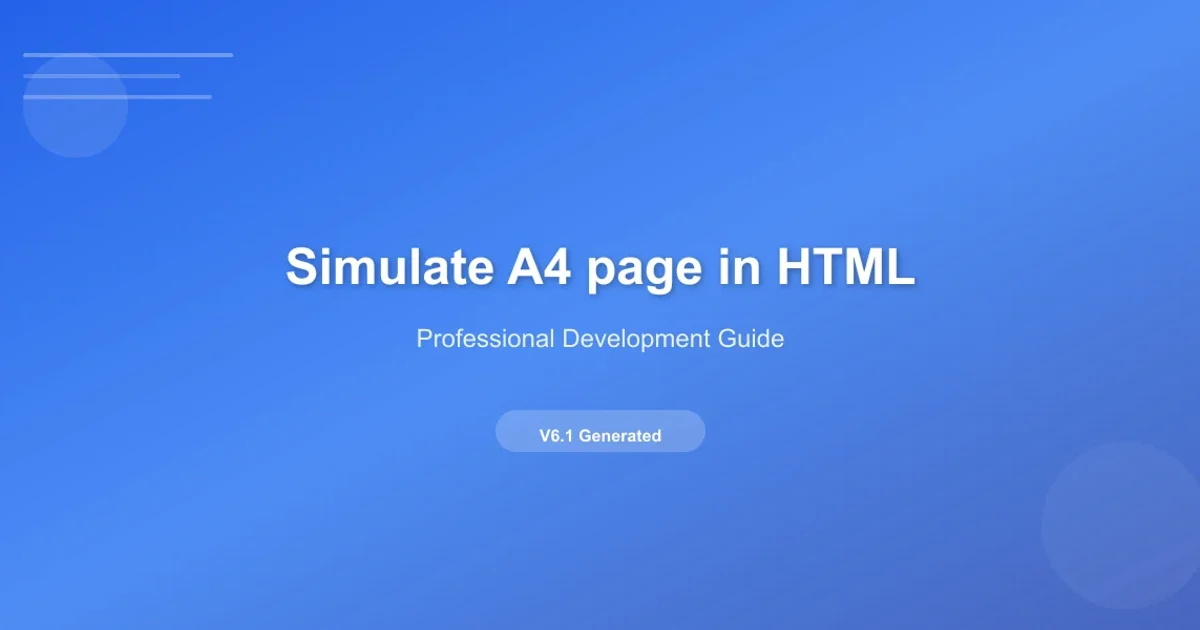Simulate A4 page in HTML
Categories:
Simulating A4 Page Layouts in HTML for Print and PDF

Learn how to effectively simulate A4 page dimensions in HTML, ensuring your web content prints correctly and generates well-formatted PDFs.
Designing web content that looks good on screen is one thing, but ensuring it translates perfectly to print or PDF can be a significant challenge. When dealing with documents intended for physical output, such as reports, invoices, or certificates, adhering to standard paper sizes like A4 is crucial. This article will guide you through the process of simulating an A4 page layout using HTML and CSS, focusing on techniques that provide consistent results across different browsers and when generating PDFs.
Understanding A4 Dimensions and CSS Units
The A4 paper size is an international standard, measuring 210mm x 297mm. When translating these physical dimensions to web design, it's important to consider CSS units. While px (pixels) are common for screen display, they are resolution-dependent and not ideal for print. For print-specific layouts, mm (millimeters), cm (centimeters), in (inches), or pt (points) are more appropriate as they directly correspond to physical measurements.
mm, cm, in, pt) for print-specific CSS to ensure accurate scaling and layout on paper. Avoid px for print styles.@page {
size: A4;
margin: 0;
}
body {
width: 210mm;
height: 297mm;
margin: 0 auto;
padding: 10mm;
box-sizing: border-box;
background-color: #f0f0f0; /* For visual separation on screen */
box-shadow: 0 0 5mm rgba(0, 0, 0, 0.2); /* For visual separation on screen */
}
Basic CSS for an A4 page container and print-specific page settings.
Implementing A4 Layout with CSS Media Queries
To ensure your A4 layout only applies when printing or generating a PDF, you should use CSS media queries. The @media print rule allows you to define styles that are specifically applied when the document is sent to a printer. This way, your on-screen display can remain fluid and responsive, while your print output adheres to the A4 standard.
flowchart TD
A[HTML Document] --> B{Browser Rendering}
B -->|Screen Display| C[Responsive Layout]
B -->|Print Command| D{Media Query @media print}
D -->|Applies Print Styles| E[A4 Page Layout]
E --> F[Printer/PDF Output]Workflow for applying A4 print styles using media queries.
/* General screen styles */
body {
font-family: Arial, sans-serif;
color: #333;
}
.container {
max-width: 960px;
margin: 20px auto;
padding: 20px;
background-color: #fff;
border-radius: 8px;
}
/* Print-specific styles */
@media print {
body {
width: 210mm;
height: 297mm;
margin: 0;
padding: 0;
background-color: #fff;
box-shadow: none;
overflow: hidden; /* Prevent scrollbars in print */
}
.container {
width: 100%;
height: 100%;
margin: 0;
padding: 10mm;
border-radius: 0;
box-shadow: none;
box-sizing: border-box;
}
/* Hide elements not needed for print */
.no-print {
display: none !important;
}
/* Force page breaks */
.page-break {
page-break-before: always;
}
}
Combining screen and print styles using @media print.
Handling Page Breaks and Margins
For multi-page documents, managing page breaks is essential. CSS properties like page-break-before, page-break-after, and page-break-inside (or their newer break-before, break-after, break-inside equivalents) allow you to control where pages split. Additionally, the @page rule is crucial for setting global page margins for the entire document, overriding default browser print margins.
@media print {
@page {
margin: 15mm 10mm; /* Top/bottom 15mm, left/right 10mm */
}
h1 {
page-break-after: avoid;
}
table {
page-break-inside: auto;
}
tr {
page-break-inside: avoid;
page-break-after: auto;
}
.new-page {
page-break-before: always;
}
}
CSS for managing print margins and page breaks.
page-break-* properties can vary. Test your print styles thoroughly across different browsers (Chrome, Firefox, Edge) and PDF generators to ensure consistent results.1. Define Base A4 Container
Create a main container element (e.g., a div with class page) that will represent your A4 page. Set its width to 210mm and min-height to 297mm within a @media print block.
2. Apply Print-Specific Margins
Use the @page rule in your CSS to define global margins for the printed document. This ensures content doesn't get cut off by default printer margins.
3. Control Page Breaks
Utilize page-break-before, page-break-after, and page-break-inside on specific elements (e.g., headings, tables, sections) to control where new pages begin and prevent awkward content breaks.
4. Test Thoroughly
Open your HTML file in a browser, use the browser's print preview function (Ctrl+P or Cmd+P), and save it as a PDF to verify the layout, margins, and page breaks are as expected.